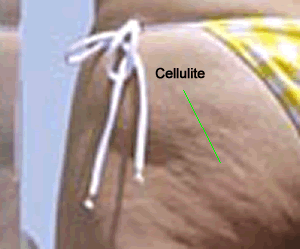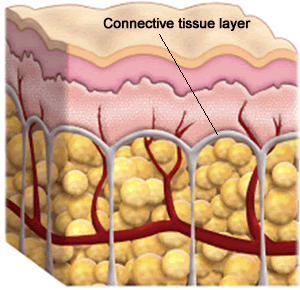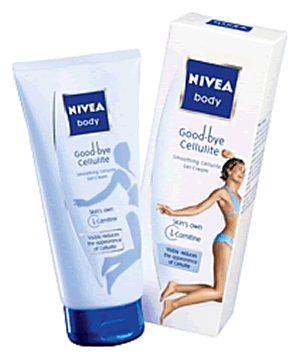Cellulite is a major complaint from many people (mainly women but men also suffer from cellulite) in western countries. It is a source of great dissatisfaction and anxiety with one's appearance especially as summer approaches and clothes are shed for more comfortable attire. This anxiety, which is largely cultural, has created an environment for great exploitation and big bucks are to be made by cosmetics firms and medical practitioners that promise products and procedures that seek out and destroy the lumpy fat on thighs and other parts of the body.
In our fat-phobic society vast amounts of time and money have gone into trying to find ways to dissolve these nuisance fat nodules. Ways that includes lasers and caffeine creams.
As yet no cure is forthcoming.

As fat pushes up on the connective layer, as shown on the right, it forms the bumpy surface on the skin that is referred to as cellulite. With age comes a decreased ability to produce collagen and the connective tissue becomes weaker. As an increasing amount of fat is deposited, fat cells become larger and start to push through the connectve tissue creating the bumps that are indicative of cellulite. The connective tissue arrangement of females, shown on the right, predisposes the skin to the development of cellulite.
Males tend to have a different fat-cell structure in the layer of fat just under the dermis. Connective tissue is arranged in a crisscrossed arrangement that tends to prevent bulging of enlarged fat cells. Click to see the connective tissue structure of males.

So what can be done to remove or reduce cellulite? Well, it is generally agreed that dietary factors have a role to play as does exercise.
Creams are sold with many chemical recipes such as the Nivea Good-Bye Cellulite Gel-Cream and others. These creams contain chemicals such as caffeine and L-carnitine which claim to help to break down fat in the body. Such chemicals are shown to work in isolated cell cultures in test tubes or when present in the body in the right concentrations. However, the question remains if these chemicals are able to penetrate the skin, a natural barrier, and if so do they accumulate in the right concentration at the desired place under the skin to be effective.

This article was written in Scientific American May 4, 2009 titled Is Cellulite Forever? By Katherine Harmon
So can anything—other than a serious overhaul of cultural beauty standards—really conquer these less-than-darling dimples? We spoke with osteopathic physician Lionel Bissoon to help us get to the bottom (so to speak) of some of the cellulite hoopla. Bissoon runs a clinic for mesotherapy (injections of homeopathic extracts, vitamins and/or medicine designed to reduce the appearance of cellulite) in New York City, and is the author of the book The Cellulite Cure published in 2006.
[An edited transcript of the interview follows.]
What exactly is cellulite?
It's a condition that affects 90 percent of women and 10 percent of men, mostly in industrial nations. As women start approaching menopause, estrogen starts decreasing. From 25 to 35 is when you start seeing the appearance of cellulite. Estrogen has an impact on the blood vessels. When estrogen starts to decrease, you lose receptors in blood vessels and thighs, so you have decreased circulation. With decreased circulation you get less oxygen and nutrition to that area, and with that we see a decrease in collagen production…. [Also, at this time] fat cells start becoming larger, [they] begin protruding through the collagen [and become the bumpy fat known as cellulite].
Women tend to get cellulite around knees, saddlebags and buttocks, because they have three layers of fat in these areas [instead of just one]. Women also have three levels of fat in the stomach and in the triceps areas.
Does cellulite serve a purpose?
I don't think it has an evolutionary purpose. I think as people have evolved in an industrial society, we've become lazier. Our jobs are sitting at a desk, answering the phone. We don't go to the gardens and pick our food—we drive to the store and park in the spot closest to the building. So we've become more sedentary as a culture.
The bulk of the articles on cellulite in the scientific literature started in about the late '70s, but you [could] say women didn't expose their legs [much before then]. What I try to do is find old picture books, women in the 1950s or 1960s…. When you find these pictures, women had perfect legs. And back in the '40s and '50s they didn't have the computer programs to retouch those photos.
Why do women get cellulite more than men?
The [structure of] collagen, the main protein of connective tissue, in women has the appearance of a picket fence, whereas in men it looks more liked a cross-linked fence. So you can see the cross-linked structure is much stronger [and will hold fat in better].
Another reason women get cellulite has to do with the [two kinds of] adrenergic receptors. When stimulated, alpha receptors will cause fat cells to produce fat [as well as triggering constriction of blood vessels and release of sugar into the bloostream] when beta receptors are stimulated, they break down fat [as well as increasing heart rate and relaxing blood vessels]. In women, for every one beta receptor in the thigh, there are nine alpha receptors.
Estrogen also makes fat whereas testosterone breaks down fat. So a women's body is basically—and I hate to say it—genetically designed to be a place for cellulite to develop. Men have one layer of fat throughout their entire body and a one-to-one alpha- and beta-receptor ratio.
Today we're seeing younger women developing cellulite—women in their teenage years are getting cellulite. How do you explain that? Too much estrogen makes fat cells larger, so…younger women who are overweight might have a condition called estrogen dominance, which means they are making too much estrogen and/or are eating foods [such as soy or using containers that leak bisphenol-A] that have estrogen-mimicking ingredients.
Why do some women have more cellulite than others?
I've spent a lot of time traveling in developing countries and photographing local women. When I photograph these women [who don't have much, or any, cellulite], you see the kind of work they're doing and the kind of food they're eating. They're eating all organic foods, they're constantly moving from the time they get up. These women are washing clothes in the river. Getting water [in an industrialized country] means getting up and going to the fridge or faucet. For women in developing countries, they're walking to the river and coming back carrying a heavy container. So the physical activity levels in industrialized nations have also decreased.
Many women wear regular underwear with elastic across the buttocks. When you see panty lines, it's cutting off circulation—just think what it's doing to your body. Look, take a tourniquet, put it around your leg and see what happens. And a lot of women wear underwear under panty hose. The panty hose force the lymphatic drainage back into the body. It's like turning the hose on and clamping it so every thing gets backed up.
Cellulite didn't become a problem until the 1970s and 1980s when the diet and activity and underwear started changing. Back in the '20s, women wore longer skirts and the underwear was loose, almost like pajamas. Cellulite is always underneath where the elastics go, and if you draw an invisible line where the cellulite is, you will see where the panty lines are. I tell people the most important preventive thing you can do, if you can't afford treatment, is change your [style of] underwear.
Does diet play a big role in the amount of cellulite people get?
Diet does play a role, because look, women in Asia, what do they have for breakfast? Noodles—it's a high-calorie meal, but when they go to work they burn those calories. In contrast, we eat these calories, then go to work and sit at a desk. Think of those [fat-producing] alpha receptors just waiting to rock and roll.
So, it all goes together. That's why women struggle to lose weight below the waist. From the waist up, for every four receptors that break down fat, there are five that make it, so it's almost a one-to-one ratio. From the trunk up, there's just one layer of fat, except for the triceps arm area.
It's really a whole biochemistry. People tell you: Don't eat fat, don't eat sugar. It's really more than that. It's hormone balance—you need to eat healthy, you need activity.
How big a role do genes play in cellulite levels?
There is a genetic component or predisposition to cellulite. But just because you have the genetic component doesn't mean you have to develop it if you do the right things: eat a healthy diet, exercise, and skip restrictive underwear.
Do creams—thigh creams, caffeine creams—really work?
Most all creams will only address the fat. So the Nivea [Good-Bye Cellulite Gel-Cream] and others with L-Carnitine transports fats into the [cells'] mitochondria to be used as energy. Caffeine creams will help by blocking the making of fats by the alpha receptors. Some creams have aminophylline, (a compound in some respiratory drugs) which, like caffeine, works by blocking the alpha receptors. In most creams, you find some way of targeting only the fat cells [and not addressing the connective tissue or circulation aspects of cellulite].
What other treatments are there for cellulite?
There are three treatable components of cellulite: You have to address the collagen; you have to reduce the fat, and you have to increase circulation.
But it depends on the grade of cellulite you have. There are four grades, ranging from zero to three: Grade zero is no visible cellulite. If you pinch the skin and see a cottage cheese–like texture—that's grade one. Grade two is if cellulite is visible on the legs of someone standing. Grade three is if you see cellulite when you look in the mirror or lie down. I call grade three "terminal," because it's very hard to treat, although the good news is that I don't think anyone's ever died of it.
Machines to treat cellulite include vacuum rolling and radio waves to break up the fat. The first one of them on the market was Endermologie. When you're vacuuming and rolling [the skin], you're increasing circulation, and the heat helps to break down the fat, which smoothes out the skin.
The downside to the machines is you have to go once a month [for at least several years].
What about lasers, injections and surgery?
Laser treatments are combined with massage and rolling; they either do suction or rolling and use radio waves and heat up the fat—put fat on a stove in a frying pan, and it melts. [Those treatments] heat it up and hope we can break it down that way, and use section and rollers to try to force it out [of the puckered near-skin area].
"Subcision" surgery was invented to get rid of indentations in the face (such as acne scarring), and one dermatologist took that technology and applied it to dimples in the buttocks. For subcision, you anesthetize the area, then you take a special needle—a Nokor needle, which looks kind of like a little hatchet—so you can make a small incision and, moving it back and forth, you can cut the skin from the tissue holding [it] down, getting rid of the dimples.
I've see women who have had fat injected into their thighs, buttocks, bellies and anyplace else they have cellulite in an attempt to even out the texture—and it was like a bump sticking out of the leg. Other injections you have to have every few months.
The bad thing about silicone [and fat-transfer] injections [that aim to fill in the dimples] that they can move and can get absorbed—and you can't get rid of it. As for liposuction [when plastic surgeons literally suck out the fat through a tube], you'll find tons of women who complain that the procedure actually made their cellulite worse. Liposuction has only been proven to work for body sculpting [changing the body's contours by removing excess fat from some areas of the body, which doesn't have much—if any—effect on the texture of fat that will remain below the skin]. If you have a doctor telling you that you can get rid of cellulite with liposuction, run out that door and don't ever look back